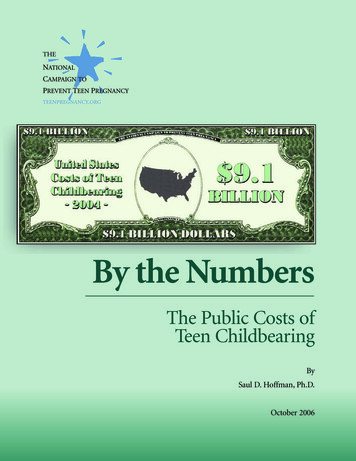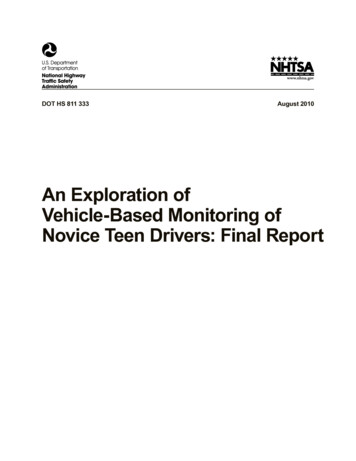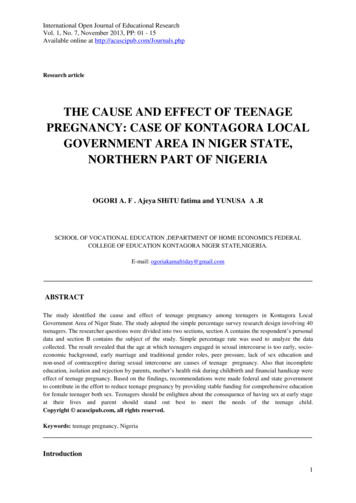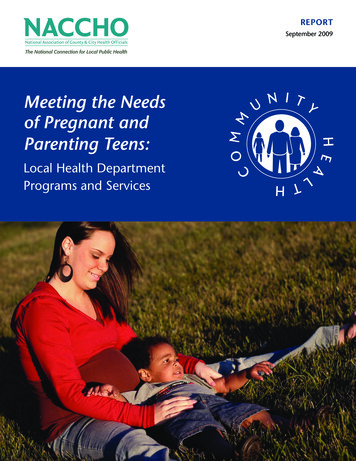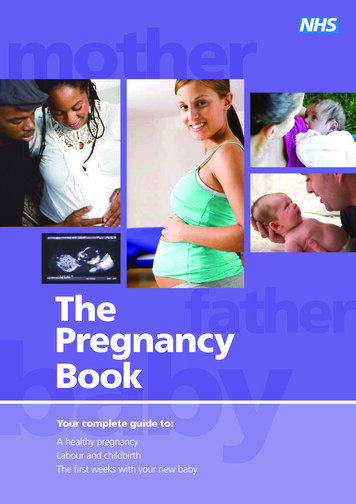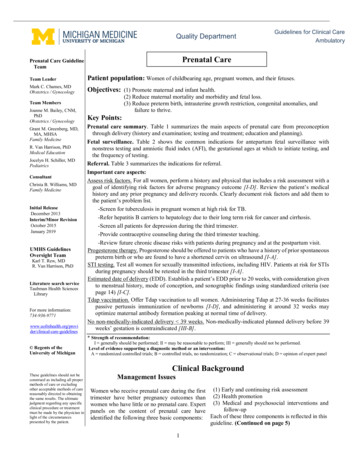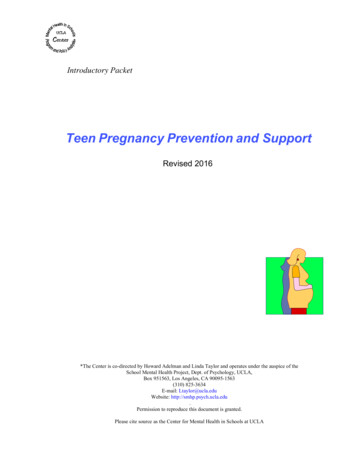
Transcription
Introductory PacketTeen Pregnancy Prevention and Support(Revised 2016*The Center is co-directed by Howard Adelman and Linda Taylor and operates under the auspice of theSchool Mental Health Project, Dept. of Psychology, UCLA,Box 951563, Los Angeles, CA 90095-1563(310) 825-3634E-mail: Ltaylor@ucla.eduWebsite: http://smhp.psych.ucla.edu.Permission to reproduce this document is granted.Please cite source as the Center for Mental Health in Schools at UCLA
Teen Pregnancy: Prevention and Support“Adolescent pregnancy, always a feature of American life, has traditionally been a private familymatter. What makes it a pressing public issue today is the changing social environment in which itis occurring and the growing awareness of its wider social consequences.”Brindis & JeremyIntroduction .1I. Conflicts and Controversy . 2A. Is teen pregnancy a problem? .3B. Is it the school’s business? .4C. The impact of social and psychological factors on teen pregnancy .11D. Understanding the risks/protective buffers/promoting full development .21E. Controversies about the best approach .27II. Looking at the facts . 40Statistics, including socioeconomic and ethnic disparities .40III. Reducing teen pregnancy . 45A. Policies .46B Programs and guidelines .52C. Evidence based practices . 55IV. Working to Improve Policy and Practice.58A. Addressing Gaps .59B. Broadening Supports .73V. Resources .75A. References .76B. Websites and Organizations.78C. Quickfind. 3
IntroductionTeen Pregnancy Prevention andSupport for Parenting TeensThere are few areas related to adolescents and schools that are ascontroversial as reproductive education. Mirroring society’s debate aboutfreedom of choice regarding pregnancy, people have strong opinions andbeliefs about these matters and these are reflected in programs and practicesfor youth.Because of the controversy in this areas, we have framed this documentaround the arguments. We hope to show evidence-based information that willbe helpful in program planning and policy development to responsiblyaddress the problem of unintended teen pregnancy.Too often the politics or the traditional approaches to providing information isthe end of the discussion. Because psychological and social factors play sucha prominent role in youngsters’ sexual behavior and decision making, wehave tried to bring information related to these matters into the discussion.We are interested in your response to these materials and invite you to shareinformation you feel should be included.1
I. Conflicts and ControversyA. Is teen pregnancy a problem?B. Is it the school’s business?C. The impact of social and psychological factors onteen pregnancyD. Understanding risks/protective buffers/promotingfull developmentE. Controversies about the best approach2
I. Conflicts and ControversyA. Is teen pregnancy a problem?Teen Pregnancy Prevention andUnited States s pregnancy combo.pdfWhat is the problem?The 2013 national Youth Risk Behavior Survey indicates that among U.S. high school students:Sexual Risk Behaviors 47% ever had sexual intercourse. 6% had sexual intercourse for the first time before age 13 years. 34% had sexual intercourse with at least one person during the 3 months before the survey. 41% did not use a condom during last sexual intercourse. (1) 14% did not use any method to prevent pregnancy during last sexual intercourse. (1) 75% did not use birth control pills; IUD or implant; or shot, patch, or birth control ring to prevent pregnancy during lastsexual intercourse. (1)Alcohol and Other Drug Use 22% drank alcohol or used drugs before last sexual intercourse. (1)What are the solutions?Better health education More comprehensive health servicesWhat is the status?The School Health Policies and Practices Study 2014 indicates that among U.S. high schools:Health Education 88% required students to receive instruction on health topics as part of a specific course.As part of a required health education course: 72% taught how to prevent pregnancy. 64% taught how to find valid information or services related to pregnancy or pregnancy testing. 76% taught abstinence as the most effective method to avoid pregnancy, HIV, and other STDs. 61% taught methods of contraception. 53% taught how to obtain contraception. 35% taught how to correctly use a condom. 50% taught how to obtain condoms. 76% taught the relationship between alcohol or other drug use and the risk for HIV, other STDs, and pregnancy.Health Services 11% provided contraceptives at school.7% made condoms available to students at school.41% provided pregnancy prevention services at school in one-on-one or small-group sessions.12% provided contraceptives to students through arrangements with providers not located on school property.1. Among students who were currently sexually active.Where can I get more information? Visit www.cdc.gov/healthyyouth/data/ or call 800-CDC-INFO (800-232-4636).3
I. Conflicts and Controversy (Cont.)B. Is it the School’s Business?“Stay out of my business!”“It’s none of your business!”While adolescents frequently feel that well meaning adults intrude intomatters that they wish to keep confidential, if sexual behavior leads topregnancy, it’s everyone’s business.Schools have an opportunity to address reproductive health and enhanceacademic outcomes for students.1.Excerpt from “Partners in Progress: The EducationCommunity and Preventing Teen Pregnancy”2.Working with Schools3.Education Laws and Pregnant and Parenting Students4
I. Conflicts and Controversy (cont.)B. Is it the School’s Business?1. Excerpt from:Partners in Progress: The Education Community and Preventing TeenPregnancyAMCHP’s National Campaign to Prevent Teen Pregnancy and the Joint Work Group on School-Based TeenPregnancy Prevention, May g.pdf.partnersprogress.pdfIntroductionBecause the relationship between academic failure and teen pregnancy is so strong, and because young people spend somuch of their time in school, the education community and the teen pregnancy prevention community should seethemselves as natural allies.Too often, however, schools find themselves caught in the middle of community controversies over sex education, inparticular, and the potential for schools to help reduce teen pregnancy gets lost. In response, this document offers simpleideas on ways the education community can help prevent teen pregnancy — most of which are not at all controversial —without sacrificing its core mission of education.The Relationship Between Academic Failure and Teen Pregnancy.Although all students are at risk for engaging in early sexual activity and childbearing, school failure is often the firstsign of trouble that can end in teenage parenthood. In fact, half of teen mothers drop out of school before becomingpregnant. Recent studies make clear that students who feel a strong connection to their school are much more likely topostpone sexual activity and other risky behaviors. Teenage parenthood is also a leading correlate of school failure —less than one third of teens who begin families before age 18 ever complete high school. All of which suggests that themost important role for schools in preventing teen pregnancy is to prevent school failure and drop-out and offer allstudents the opportunity to succeed and to become deeply engaged in their own education.Is Teen Pregnancy Still a Concern?Since the early 1990s, teen pregnancy and birth rates have declined nationwide, in all states, and among all age andracial/ethnic groups — the result of less sexual activity and better contraceptive use. This good news shows that efforts toprevent teen pregnancy are paying dividends. Despite these encouraging declines, the United States has the highest ratesof teen pregnancy and birth among comparable nations. And it is still the case that four out of ten girls in the U.S.become pregnant at least once before age 20.The Consequences of Teen Pregnancy.Teen pregnancy and childbearing have adverse academic consequences for teen parents and their children. In addition toa higher drop-out rate for the young mothers and fathers, early parenting limits a young mother’s likelihood of a gettingthe post-secondary education that is increasingly necessary to qualify for a well-paying job. Not surprisingly, limitededucational achievement increases the chances that teen parents will live in poverty. Teen fathers tend to complete anaverage of one semester of school less than young men who delay father-hood until at least age 21. The children of teenmothers are also at risk compared to those born to older parents. They are 50 % more likely to repeat a grade, theyperform worse on standardized tests, and ultimately they are less likely to complete high school than if their mothers haddelayed childbearing.5
Ways Schools Are Helping Prevent Teen Pregnancies.Schools play a vital role in the lives of 50 million children each year. By promoting educational success, developingskills that help build a positive future, and by helping young people to feel a strong sense of purpose, schools can helpstrengthen young people’s motivation to delay pregnancy and parenthood. Schools can — and should — also providesexuality education, and clearly schools are doing so. Although curricula vary widely in both focus and intensity, nearlyevery teenager in the United States receives some form of comprehensive sex or abstinence education. For their part,parents have expressed consistent and strong support for school-based sex education that stresses abstinence as the firstand best choice for youth and provides information about contraception. Parents also want schools to go beyond just the“birds and the bees” and address such issues as how to manage pressure to have sex and the emotional consequences ofbecoming sexually active. For those concerned that discussing sex and contraception with young people might have anegative impact, there is good news. The over-whelming weight of the evidence is that sex education that addresses boththe benefits and limitations of contraception does not hasten the onset of sex, increase the frequency of sex, nor increasethe number of sexual partners. In addition, several sex and HIV education curricula have now been shown to delay theonset of sex, reduce the frequency of sex, reduce the number of sexual partners among teens, and/or increase the use ofcontraception.Two important caveats: (1) When it comes to preventing teen pregnancy, schools can do more than just offer sexeducation classes. For instance, schools can host parent forums or can provide health clinic services. (2) Regardless ofthe type of sex education curriculum that schools offer, it is important to recognize that teens receive information andguidance about sex from a variety of sources — parents, television, the Internet, friends, and faith communities, to namejust a few. Consequently, it is unreasonable to expect that the education community alone should shoulder the entireburden of the sexual education of young people or be responsible for putting all of the complex issues of love, sex, andrelationships in just the context that each family prefers. Moreover, there is very strong agreement within the educationcommunity that schools alone cannot address the issue of adolescent pregnancy. While there are a variety of approachesfor pre-venting teen pregnancy through schools, support from families, in particular, and the community in general, isessential if prevention programs are to work successfully.The following tips are designed primarily to help those in the education community strengthen their existingcommitments to preventing teen pregnancy and to provide new ideas. It is our hope that these tips also provide someguidance to those outside of schools who are also concerned with how to reduce teen pregnancy but need new ideas forconstructive partnerships with schools.Tips for Success Set High Academic Standards for all Students.Students respond best to a strong education program that is stimulating, establishes expectations for all students,and clearly articulates what each student should know and be able to accomplish. Involve Parents.Teens consistently cite parents as having the most influence over their sexual decision-making. A solidrelationship between a teen and his or her parents is positively related to healthy emotional development andself-esteem. Ongoing, sustained communication between parents and their teens can help prevent teenpregnancy, as well as a host of other risky behaviors. Involve Youth.Giving young people meaningful roles in developing and running a teen pregnancy prevention program iscritical to the success of such efforts. Their input helps ensure that a program is relevant and that messages,products and methods reach their intended audience. Do Your Homework.Become and stay informed about teen pregnancy and about promising interventions. Gather data on the need forpregnancy prevention in your community — make the issue local.6
Prepare Teachers.Students cite teachers and counselors as second only to their families as the most reliable sources of sex-relatedinformation. Use the Youth Development Framework.Evidence increasingly supports the view that after-school activities, community service, and other youthdevelopment programs help to foster self-esteem, “resiliency,” and academic achievement. In fact, currentresearch suggests that programs that include community service by teens and structured time for preparation andreflection before, during, and after such service (e.g., group discussions, journal writing, and papers) may have thestrongest evidence of any intervention that they actually reduce teen pregnancy rates while the youth areparticipating in the program. Create an Environment for Success.When designing and operating programs that address teen pregnancy, make sure to find friends and advocatesoutside the education community, such as state and local coalitions focused on preventing teen pregnancy. Let Research Help Guide Your Efforts.When designing, assessing, and evaluating policies and programs that address teen pregnancy, it is helpful toknow that there exists an increasing body of science that can help guide your decisions and efforts.AMCHP: http ://www.amchp.org7
I. Conflicts and Controversy (cont.)B. Is it the School’s Business? (cont.)Healthy Teen Network2. Working with choolsHealthy Teen Network Resources Summary: Systematic Literature Review of the Association Between School Climateand Adolescent Sexual and Reproductive Health Summary: Systematic Literature Review of the Association Between School Climateand Adolescent Sexual and Reproductive Health (PowerPoint) Instructor Interview Tool Instructor Observation Tool What’s going on in the classroom? Tips for assessing the implementation ofsexuality education Art of Storytelling Instructor Competency Assessment ToolOther Resources School-Based Health Centers Literature Database Evidence-Based Sexuality Education Programs in Schools: Do They Align With theNational Sexuality Education Standards? Measuring School Health Center Impact on Access to and Quality of Primary Care How Pregnancy Planning and Prevention Help Students Complete College Differences in Adolescent Relationship Abuse Perpetration and Gender-InequitableAttitudes by Sport Among Male High School Athletes Teacher’s Guide: Interesting, Fun, and Effective Classroom Activities To InfluenceTeen Dating Violence Awareness and Prevention8
Sexual Assault Risk Reduction Curriculum Evaluation of a Statewide Youth-Focused Relationships Education Curriculum Impact of a School-Based Dating Violence Prevention Program among Latino Teens:Randomized Controlled Effectiveness Trial Unwanted Sexual Contact on Campus: A Comparison of Women's and Men'sExperiences Family Homework and School-Based Sex Education: Delaying Early Adolescents'Sexual Behavior The Relationship Between Parental Involvement and Urban Secondary SchoolStudent Academic Achievement: A Meta-Analysis Parent Engagement: Strategies for Involving Parents in School Health School Connectedness: Strategies for Increasing Protective Factors Among Youth Answer: Sexuality Education Policy by State Centers for Disease Control and Prevention: School Health Policies and PracticesStudy (SHPPS) Improving Outcomes for Teen Parents and Their Young Children by StrengtheningSchool-Based Programs. Challenges, Solutions, and Policy Implications Promising Outcomes in Teen Mothers Enrolled in a School-Based Parent SupportProgram and Child Care Center Access to and Use of Vocational Education in Teen Parent Programs Prepped for Success? Supporting Pregnant and Parenting Teens in Chicago Schools Promoting Sexual Responsibility: A Teen Pregnancy Prevention Resource for SchoolEmployees Beyond Teacher Training: The Critical Role of Professional Development inMaintaining Curriculum Fidelity Building the Missing Link between the Common Core and Improved Learning Success by Ten: Intervening Early, Often and Effectively in the Education of YoungChildren Listening to Latinas: Barriers to High School Graduation How to Work with Schools to Conduct STD ScreeningHealthy Teen Network 1501 Saint Paul St., Ste. 124 Baltimore, MD 21202 p: (410) 685-0410f: (410) 685-04819
I. Conflicts and Controversy (cont.)B. Is it the School’s Business? (cont.)Resource3. A Pregnancy Test for Schools:The Impact of Education Laws on Pregnant and Parenting ant-and-parenting-students/Parenthood is not the end of the road for teen moms. Quite to thecontrary, motherhood can serve as an educational motivator formany young women. Unfortunately, educational barriers anddiscrimination often thwart this drive and determination. Title IX ofthe Education Amendments of 1972 is the landmark law that banssex discrimination in federally funded education programs andactivities. Despite Title IX’s prohibition against sex discrimination,there are schools across the country that continue to bar pregnantand parenting students from activities, kick them out of school,pressure them to attend alternative programs, and penalize themfor pregnancy-related absences.A Pregnancy Test for Schools outlines the ways that federal, state, and local laws, policies, andprograms can change the landscape for pregnant and parenting students and ranks how well the statelaws and policies address the needs of these students. The report describes the particular challengesfaced by pregnant and parenting students, highlights the requirements of federal laws, reviews relevantstate laws and policies (some promising and others sorely lacking), and concludes with recommendationsfor both policymakers and for schools.Below we’ve also provided resources for advocates and service providers who work with these youth;download our toolkit to find out how you can help to make a difference. Full ReportExecutive SummaryToolkitFact Sheet for Schools Pregnant & Parenting Students Bill of Rights Wallet CardPUBLISHED ON: June 18, 2012ASSOCIATED ISSUES: Education & Title IX, Pregnancy & Parenting,Pregnant & Parenting Students, School Discipline & Dropout Prevention10
I. Conflicts and Controversy (cont.)C. The Impact of Social and Psychological Factors on Pregnancy1. Social Factorsa. Poverty/culture/familiesb.Media impact2. Psychological Factors11
I. Conflicts and Controversy (cont.)C. The Impact of Social and Psychological Factors on Pregnancy (cont.)1.Social Factorsa.Poverty/culture/FamiliesThe Impact of Social and Psychological Factors on PregnancyTeenage pregnancy is both a personal issue and a societal issue; thus, a number ofpsychological and social factors have important effects on adolescent childbearing. From apsychological point of view, it is important to examine the factors which lead teens to engagein risky sexual behavior; substance abuse, exposure to violence, sexual victimization, and“nothing to lose”attitudes all make a teen more susceptible, while a good relationships withparents serves as a protective factor. From a sociological point of view, it is important toacknowledge the strong relationship between socioeconomic disadvantage (e. g , poverty, loweducational attainment) and teen pregnancy; it is both a risk factor for and consequence ofadolescent parenthood. It is also important to consider the role of a media which emphasizesthe importance of sex with little mention of the risks associated with it. The followingexcerpts, taken from a variety of sources, examine teen pregnancy in the context of theseimportant social and psychological factors.12
I. Conflicts and Controversy (cont.)C. The Impact of Social and Psychological Factors on Pregnancy (cont.)1. Social Factors (cont.)a. Poverty/culture/families (cont.)Adolescent Pregnancy and Parenthoodhttp://www.actforyouth.net/sexual health/behaviors/pregnancy.cfmSexual Behaviors andHealthSexual Behaviors in AdolescenceRisk and Protective FactorsSexually Transmitted DiseasesHIV/AIDSPregnancy and ParenthoodContraceptionRelated ResourcesSexual development is central toadolescence. For more information,visit:What is Sexual Health?For statistics relating to adolescent sexualhealth, visit Demographics: Sexual Health.Communities can provide the supportivecontext youth need to avoid unplannedpregnancies or succeed as young parents. Byproviding services, opportunities, andsupports, communities foster positive youthdevelopment. By ensuring access to youthfriendly health care, they promote wellbeing. And by promoting comprehensive sexeducation, they give youth the knowledgeand skills they need to navigate relationshipsand take control of their sexual andreproductive lives.This is a tall order for any community -- especially those that are under-resourced and those wherestigma against sex and sexuality runs high. However, the consistent decline in pregnancy ratessuggests that this can be done.Understanding Sexual DevelopmentRomantic Relationships inAdolescenceHow do environmental factors affect adolescent pregnancy?Sex is a normal part of the teen years: in the U.S., two out of three people have sex before the ageof 19. But sex is a complicated part of life, connected not only to family, relationship, and individualissues, but also to myriad social and economic pressures and policies. Consider how these pressurescan weave through young people's lives: Social stigma against teen sexuality has affected Caroline in significant ways. Caroline'smother is uncomfortable talking to her about sex, and is embarrassed to ask anyone how tohave that conversation. Because they fear potential objections from parents, Caroline's highschool prohibits condom demonstrations in sex education classes as a matter of school policy.Caroline and her boyfriend Max want to use protection, but they don't know how. When thecondom breaks, Caroline's friends tell her about emergency contraception, but she lacksaccess to public transportation and is unable to get to a clinic or pharmacy in time. Shedoesn't want to go to a health center in any case because of confidentiality concerns: it's asmall town, and the odds are she will see someone she knows there. At 16, William is feeling the pressure of masculine gender norms: he is teased relentlessly forbeing a virgin. He would rather be working or doing something that will set him up for thefuture, but there are no jobs and nothing interesting to do where he lives. To pass the time,he and his friends just hang out and get high at the end of the school day. There's one girl whoseems to like him, so he might as well get it over with. Among the guys, peer norms hold thatcondoms make sex less pleasurable; condom use is rare in his crowd, and no adults offer adifferent narrative to challenge that norm. In fact, no one seems to be paying attention at all. Homophobia, violence, and poverty have all contributed to the toxic stress that accompanies15-year-old Ti through life. Identifying as queer, Ti sees no need for contraception, anddoesn't even consider going to the free clinic. But she has learned it's not safe to be gay, soshe covers her tracks by having boyfriends. Ti's school and neighborhood have no resources toprovide her with opportunities to develop her talents and plan for the future. She lives oneday at a time and prides herself on being a survivor. Kicked out of her family's home, she usessex to meet basic needs for food and shelter.PreventionThese stories suggest many points at which interventions -- from parent education to vocationalopportunities to food and shelter -- could change the trajectory of teens' lives. When it comes toadolescent pregnancy, the power of influences beyond the individual or couple involved has beenwell-researched: hundreds of risk and protective factors for adolescent sexual health have beenidentified. Together, they suggest many pathways toward empowering youth to care for their healthand plan the futures they desire.13
Because the causes of adolescent pregnancy are so complex, researchers and funders recommendthat comprehensive plans be developed and implemented at the community level. Every sector has arole to play in supporting a community's youth. Three overarching strategies can make a significantdifference through: Positive Youth DevelopmentPositive youth development has been linked to decreases in adolescent pregnancy and tobetter adolescent sexual health. This section describes positive youth development principlesand practices. Evidence-Based ProgrammingComprehensive sexual health education allows youth to build the knowledge and skills -- suchas refusing sex and using a condom correctly -- that they need to protect their health andpromote their well-being. This section focuses on how to prepare for successfulimplementation of evidence-based programs in adolescent sexual health. Access to health careYouth-friendly, confidential sexual health care is fundamental to pregnancy prevention.It's also important to note that poverty is central to many of the risk factors for youth. To supportyoung people, it is critical to address the burden of poverty carried by under-resourcedneighborhoods, and activate the strengths and resources within these communities.Support for Young FamiliesPrevention, of course, is not the end of the story: thousands of teens become parents each year. It'ssafe to say that in most communities in the U.S., adolescents who are parents are rarely supported intheir own development. Coping with the pernicious effects of stigma, they face obstacles incompleting their education and building the connections and competencies that support selfsufficiency and a healthy adulthood. At the same time, they must work to ensure the well-being oftheir children: finding safe housing and childcare, getting to health care appointments, and securingincome.When connected to supportive opportunities, young people who parent can meet their owndevelopmental challenges while raising their children. Supporting Young Parents: A ToolkitThis toolkit of online resources is for professionals who are helping young families addresstheir most pressing challenges and needs.Resources: Focus on DisparitiesAdolescent pregnancy and parenting rates have declined dramatically since 1991. However, somegroups remain disproportionately affected by unintended pregnancy, HIV, and STDs. To achievehealth equity, the social determinants negatively affecting these groups must be addressed. Seebelow for information and resources.Youth of color Advocates for Youth: Young Women of Color InitiativeAdvocates for Youth: The Reproductive and Sexual Health of Young Men of Color (PDF)Advocates for Youth: Youth of Color - At Disproportionate RiskNational Campaign: Latino CommunityRural youth National Campaign: Sex in the (Non) City: Teen Childbearing in Rural AmericaLesbian, gay, and bisexual youth ACT for Youth: Pregnancy Risk Among Bisexual, Lesbian, and Gay Youth ACT for Youth: LGBTQ Inclusion in Youth Program Environments Advocates
Please cite source as the Center for Mental Health in Schools at UCLA. Teen Pregnancy: Prevention and Support "Adolescent pregnancy, always a feature of American life, has traditionally been a private family . IUD or implant; or shot, patch, or birth control ring to prevent pregnancy during last sexual intercourse. (1)
